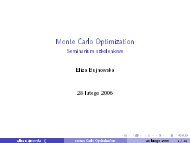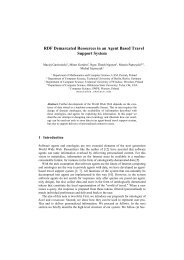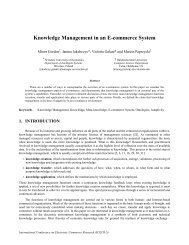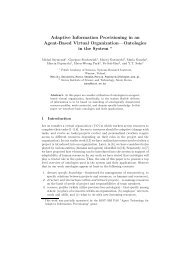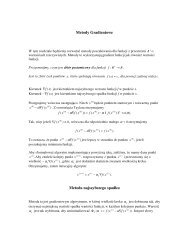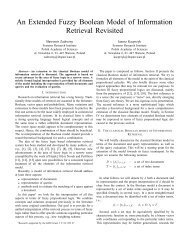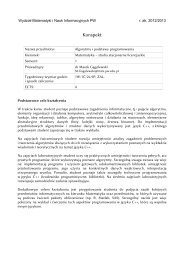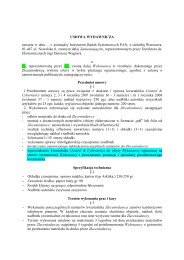Combining Information from Multiple Internet Sources
Combining Information from Multiple Internet Sources
Combining Information from Multiple Internet Sources
You also want an ePaper? Increase the reach of your titles
YUMPU automatically turns print PDFs into web optimized ePapers that Google loves.
there are set up search engines. Afterwards MA forwards the query to the each of the SA. Each SA is<br />
assigned a different search engine and MA controls engines assignment process.<br />
Having the search engines assigned, the SA can start querying the engines. After search is<br />
finished, the SAs return their result sets to the MA, which starts processing results according to the<br />
algorithm chosen by the user at the beginning. When answer processing is finished, the MA sends<br />
the final results to the web application which displays them on the webpage. There are two<br />
possibilities depending on algorithm outcome. If the algorithm was able to find the best result, the<br />
result list is displayed and knowledge base is updated instantaneously. The search engine which<br />
yielded the final result is ranked as the best and other engines are ranked according to how close<br />
they were to this engine. If, however, algorithm was not able to yield one answer; application<br />
presents a list of possibilities and displays an option to provide feedback - selection of the answer<br />
that is the most valuable (subjectively, of course). After the feedback is received application ranks<br />
the engines according to it. Engines ranks are stored in the knowledge base – for each query, search<br />
engine and method of answer processing, there are engine ranks. After MA calculates the weights<br />
those are sent to the SAs which update the knowledge base with ranks (weights) of the engine they<br />
were assigned at the beginning and application can be issued another query.<br />
In order to present to the user readable output, the vast majority of data is saved to local<br />
files. Only the top 10 results are displayed on the web page. The action of saving is done by<br />
Manager Agent. More precisely: information which is saved contains 10 top results <strong>from</strong> result sets<br />
of each search engine as well as the final result of answer processing algorithm.<br />
Below is the use case diagram which presents what are the operations of the agents. It also<br />
depicts interaction with the application, however without getting into the details of the Client<br />
module.<br />
Fig 2.2.2.1 Use case diagram of Main module<br />
11



